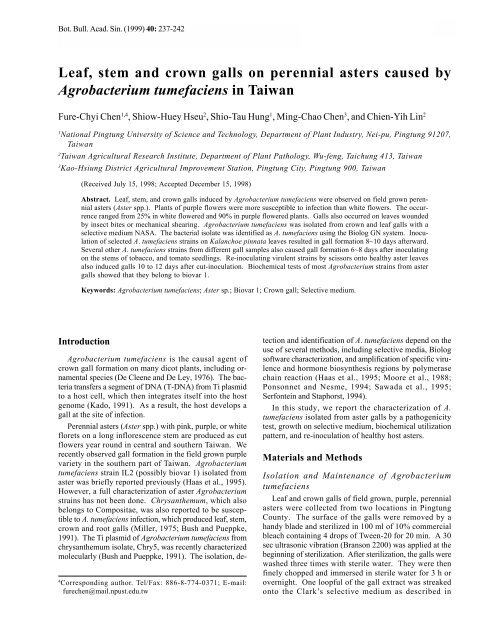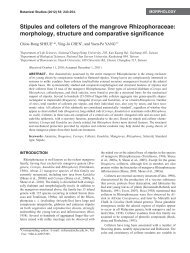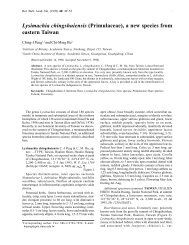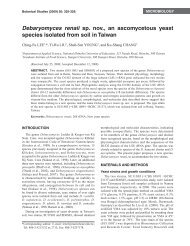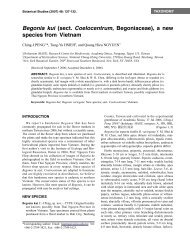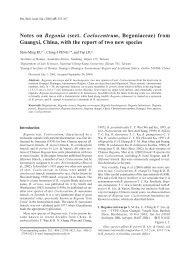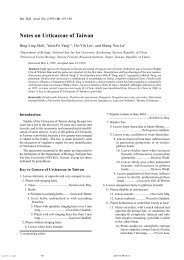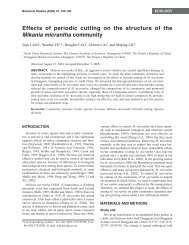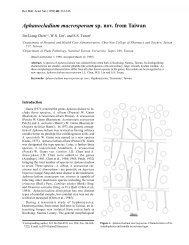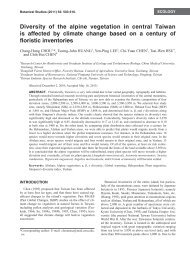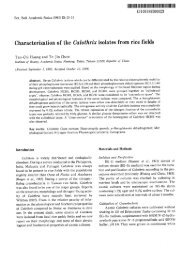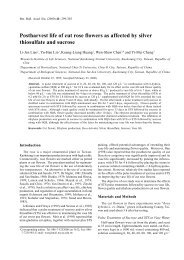Leaf, stem and crown galls on perennial asters ... - Academia Sinica
Leaf, stem and crown galls on perennial asters ... - Academia Sinica
Leaf, stem and crown galls on perennial asters ... - Academia Sinica
Create successful ePaper yourself
Turn your PDF publications into a flip-book with our unique Google optimized e-Paper software.
Chen Bot. Bull. et al. Acad. — Aster Sin. gall (1999) 40: 237-242<br />
237<br />
<str<strong>on</strong>g>Leaf</str<strong>on</strong>g>, <str<strong>on</strong>g>stem</str<strong>on</strong>g> <str<strong>on</strong>g>and</str<strong>on</strong>g> <str<strong>on</strong>g>crown</str<strong>on</strong>g> <str<strong>on</strong>g>galls</str<strong>on</strong>g> <strong>on</strong> <strong>perennial</strong> <strong>asters</strong> caused by<br />
Agrobacterium tumefaciens in Taiwan<br />
Fure-Chyi Chen 1,4 , Shiow-Huey Hseu 2 , Shio-Tau Hung 1 , Ming-Chao Chen 3 , <str<strong>on</strong>g>and</str<strong>on</strong>g> Chien-Yih Lin 2<br />
1<br />
Nati<strong>on</strong>al Pingtung University of Science <str<strong>on</strong>g>and</str<strong>on</strong>g> Technology, Department of Plant Industry, Nei-pu, Pingtung 91207,<br />
Taiwan<br />
2<br />
Taiwan Agricultural Research Institute, Department of Plant Pathology, Wu-feng, Taichung 413, Taiwan<br />
3<br />
Kao-Hsiung District Agricultural Improvement Stati<strong>on</strong>, Pingtung City, Pingtung 900, Taiwan<br />
(Received July 15, 1998; Accepted December 15, 1998)<br />
Abstract. <str<strong>on</strong>g>Leaf</str<strong>on</strong>g>, <str<strong>on</strong>g>stem</str<strong>on</strong>g>, <str<strong>on</strong>g>and</str<strong>on</strong>g> <str<strong>on</strong>g>crown</str<strong>on</strong>g> <str<strong>on</strong>g>galls</str<strong>on</strong>g> induced by Agrobacterium tumefaciens were observed <strong>on</strong> field grown <strong>perennial</strong><br />
<strong>asters</strong> (Aster spp.). Plants of purple flowers were more susceptible to infecti<strong>on</strong> than white flowers. The occurrence<br />
ranged from 25% in white flowered <str<strong>on</strong>g>and</str<strong>on</strong>g> 90% in purple flowered plants. Galls also occurred <strong>on</strong> leaves wounded<br />
by insect bites or mechanical shearing. Agrobacterium tumefaciens was isolated from <str<strong>on</strong>g>crown</str<strong>on</strong>g> <str<strong>on</strong>g>and</str<strong>on</strong>g> leaf <str<strong>on</strong>g>galls</str<strong>on</strong>g> with a<br />
selective medium NASA. The bacterial isolate was identified as A. tumefaciens using the Biolog GN sy<str<strong>on</strong>g>stem</str<strong>on</strong>g>. Inoculati<strong>on</strong><br />
of selected A. tumefaciens strains <strong>on</strong> Kalanchoe pinnata leaves resulted in gall formati<strong>on</strong> 8~10 days afterward.<br />
Several other A. tumefaciens strains from different gall samples also caused gall formati<strong>on</strong> 6~8 days after inoculating<br />
<strong>on</strong> the <str<strong>on</strong>g>stem</str<strong>on</strong>g>s of tobacco, <str<strong>on</strong>g>and</str<strong>on</strong>g> tomato seedlings. Re-inoculating virulent strains by scissors <strong>on</strong>to healthy aster leaves<br />
also induced <str<strong>on</strong>g>galls</str<strong>on</strong>g> 10 to 12 days after cut-inoculati<strong>on</strong>. Biochemical tests of most Agrobacterium strains from aster<br />
<str<strong>on</strong>g>galls</str<strong>on</strong>g> showed that they bel<strong>on</strong>g to biovar 1.<br />
Keywords: Agrobacterium tumefaciens; Aster sp.; Biovar 1; Crown gall; Selective medium.<br />
Introducti<strong>on</strong><br />
4<br />
Corresp<strong>on</strong>ding author. Tel/Fax: 886-8-774-0371; E-mail:<br />
furechen@mail.npust.edu.tw<br />
Agrobacterium tumefaciens is the causal agent of<br />
<str<strong>on</strong>g>crown</str<strong>on</strong>g> gall formati<strong>on</strong> <strong>on</strong> many dicot plants, including ornamental<br />
species (De Cleene <str<strong>on</strong>g>and</str<strong>on</strong>g> De Ley, 1976). The bacteria<br />
transfers a segment of DNA (T-DNA) from Ti plasmid<br />
to a host cell, which then integrates itself into the host<br />
genome (Kado, 1991). As a result, the host develops a<br />
gall at the site of infecti<strong>on</strong>.<br />
Perennial <strong>asters</strong> (Aster spp.) with pink, purple, or white<br />
florets <strong>on</strong> a l<strong>on</strong>g inflorescence <str<strong>on</strong>g>stem</str<strong>on</strong>g> are produced as cut<br />
flowers year round in central <str<strong>on</strong>g>and</str<strong>on</strong>g> southern Taiwan. We<br />
recently observed gall formati<strong>on</strong> in the field grown purple<br />
variety in the southern part of Taiwan. Agrobacterium<br />
tumefaciens strain IL2 (possibly biovar 1) isolated from<br />
aster was briefly reported previously (Haas et al., 1995).<br />
However, a full characterizati<strong>on</strong> of aster Agrobacterium<br />
strains has not been d<strong>on</strong>e. Chrysanthemum, which also<br />
bel<strong>on</strong>gs to Compositae, was also reported to be susceptible<br />
to A. tumefaciens infecti<strong>on</strong>, which produced leaf, <str<strong>on</strong>g>stem</str<strong>on</strong>g>,<br />
<str<strong>on</strong>g>crown</str<strong>on</strong>g> <str<strong>on</strong>g>and</str<strong>on</strong>g> root <str<strong>on</strong>g>galls</str<strong>on</strong>g> (Miller, 1975; Bush <str<strong>on</strong>g>and</str<strong>on</strong>g> Pueppke,<br />
1991). The Ti plasmid of Agrobacterium tumefaciens from<br />
chrysanthemum isolate, Chry5, was recently characterized<br />
molecularly (Bush <str<strong>on</strong>g>and</str<strong>on</strong>g> Pueppke, 1991). The isolati<strong>on</strong>, detecti<strong>on</strong><br />
<str<strong>on</strong>g>and</str<strong>on</strong>g> identificati<strong>on</strong> of A. tumefaciens depend <strong>on</strong> the<br />
use of several methods, including selective media, Biolog<br />
software characterizati<strong>on</strong>, <str<strong>on</strong>g>and</str<strong>on</strong>g> amplificati<strong>on</strong> of specific virulence<br />
<str<strong>on</strong>g>and</str<strong>on</strong>g> horm<strong>on</strong>e biosynthesis regi<strong>on</strong>s by polymerase<br />
chain reacti<strong>on</strong> (Haas et al., 1995; Moore et al., 1988;<br />
P<strong>on</strong>s<strong>on</strong>net <str<strong>on</strong>g>and</str<strong>on</strong>g> Nesme, 1994; Sawada et al., 1995;<br />
Serf<strong>on</strong>tein <str<strong>on</strong>g>and</str<strong>on</strong>g> Staphorst, 1994).<br />
In this study, we report the characterizati<strong>on</strong> of A.<br />
tumefaciens isolated from aster <str<strong>on</strong>g>galls</str<strong>on</strong>g> by a pathogenicity<br />
test, growth <strong>on</strong> selective medium, biochemical utilizati<strong>on</strong><br />
pattern, <str<strong>on</strong>g>and</str<strong>on</strong>g> re-inoculati<strong>on</strong> of healthy host <strong>asters</strong>.<br />
Materials <str<strong>on</strong>g>and</str<strong>on</strong>g> Methods<br />
Isolati<strong>on</strong> <str<strong>on</strong>g>and</str<strong>on</strong>g> Maintenance of Agrobacterium<br />
tumefaciens<br />
<str<strong>on</strong>g>Leaf</str<strong>on</strong>g> <str<strong>on</strong>g>and</str<strong>on</strong>g> <str<strong>on</strong>g>crown</str<strong>on</strong>g> <str<strong>on</strong>g>galls</str<strong>on</strong>g> of field grown, purple, <strong>perennial</strong><br />
<strong>asters</strong> were collected from two locati<strong>on</strong>s in Pingtung<br />
County. The surface of the <str<strong>on</strong>g>galls</str<strong>on</strong>g> were removed by a<br />
h<str<strong>on</strong>g>and</str<strong>on</strong>g>y blade <str<strong>on</strong>g>and</str<strong>on</strong>g> sterilized in 100 ml of 10% commercial<br />
bleach c<strong>on</strong>taining 4 drops of Tween-20 for 20 min. A 30<br />
sec ultras<strong>on</strong>ic vibrati<strong>on</strong> (Brans<strong>on</strong> 2200) was applied at the<br />
beginning of sterilizati<strong>on</strong>. After sterilizati<strong>on</strong>, the <str<strong>on</strong>g>galls</str<strong>on</strong>g> were<br />
washed three times with sterile water. They were then<br />
finely chopped <str<strong>on</strong>g>and</str<strong>on</strong>g> immersed in sterile water for 3 h or<br />
overnight. One loopful of the gall extract was streaked<br />
<strong>on</strong>to the Clark’s selective medium as described in
238 Botanical Bulletin of <strong>Academia</strong> <strong>Sinica</strong>, Vol. 40, 1999<br />
Serf<strong>on</strong>tein <str<strong>on</strong>g>and</str<strong>on</strong>g> Staphorst (1994). The medium c<strong>on</strong>tains<br />
nutrient broth, 50 mg/l sodium selenite, 250 mg/l<br />
cycloheximide, <str<strong>on</strong>g>and</str<strong>on</strong>g> 15 g/l Sigma agar, <str<strong>on</strong>g>and</str<strong>on</strong>g> was designated<br />
as NASA medium. The plates were incubated at 28°C for<br />
two days. Putative brick red col<strong>on</strong>ies from NASA were<br />
streaked <strong>on</strong> the same medium to purify single col<strong>on</strong>ies. The<br />
purified col<strong>on</strong>ies were cultured <strong>on</strong> YM medium (0.04%<br />
yeast extract, 1% mannitol, 1.7 mM sodium chloride, 0.8<br />
mM magnesium sulfate, <str<strong>on</strong>g>and</str<strong>on</strong>g> 2.2 mM dipotassium<br />
phosphate, pH 7.0, 1.5% Sigma agar) <str<strong>on</strong>g>and</str<strong>on</strong>g> stored at 4°C, or<br />
cultured in liquid YM medium overnight at 250 rpm <str<strong>on</strong>g>and</str<strong>on</strong>g><br />
frozen at -80°C with 25% glycerol until use.<br />
Diagnostic Tests <str<strong>on</strong>g>and</str<strong>on</strong>g> Carb<strong>on</strong> Utilizati<strong>on</strong><br />
Col<strong>on</strong>ies c<strong>on</strong>firmed to be Gram negative bacteria, according<br />
to the method of Suslow et al. (1982), were streaked<br />
<strong>on</strong> Tryptic soy agar (TSA medium: Bacto trypt<strong>on</strong>e 15 g/l,<br />
Bacto Soyt<strong>on</strong>e 5 g/l, Sodium chloride 5 g/l, Difco-Bacto<br />
agar 15 g/l) <str<strong>on</strong>g>and</str<strong>on</strong>g> incubated at 28°C overnight. They were<br />
applied into a microtiter plate c<strong>on</strong>taining 95 substrates.<br />
The ability to catabolise different compounds was measured<br />
by an ELISA reader <str<strong>on</strong>g>and</str<strong>on</strong>g> compared by Biolog software<br />
(Biolog Inc., Hayward, CA, USA). Bacterial col<strong>on</strong>ies<br />
were identified using the Biolog GN sy<str<strong>on</strong>g>stem</str<strong>on</strong>g> according to<br />
manufacture’s directi<strong>on</strong>s (Microlog 3.5, Biolog Inc.,<br />
Hayward, CA, USA).<br />
Diagnostic tests for physiological <str<strong>on</strong>g>and</str<strong>on</strong>g> biochemical characterizati<strong>on</strong>s<br />
were c<strong>on</strong>ducted according to Moore et al.<br />
(1988).<br />
Pathogenicity Test<br />
The bacteria slurry grown <strong>on</strong> the YM medium was<br />
scraped off with a sterile surgery scalpel <str<strong>on</strong>g>and</str<strong>on</strong>g> slash-inoculated<br />
<strong>on</strong> both sides of the upper leaf epidermis of<br />
kalanchoe, Kalanchoe pinnata (Minnemeyer et al., 1991).<br />
The inoculated plants were cultivated <strong>on</strong> a balc<strong>on</strong>y outside<br />
the laboratory. A c<strong>on</strong>trol slash was made without<br />
bacteria. Gall formati<strong>on</strong> was scored two m<strong>on</strong>ths after<br />
inoculati<strong>on</strong>. Selected stains were also inoculated <strong>on</strong> the<br />
<str<strong>on</strong>g>stem</str<strong>on</strong>g>s of tomato (Lycopersicum esculentum cv. Known-<br />
You 301) <str<strong>on</strong>g>and</str<strong>on</strong>g> tobacco seedlings (Nicotiana tabacum cv.<br />
Xanthi NC). Col<strong>on</strong>ies were also applied <strong>on</strong>to the top surface<br />
of carrot slices after surface sterilizati<strong>on</strong> by immersi<strong>on</strong><br />
<str<strong>on</strong>g>and</str<strong>on</strong>g> shaking in diluted Clorox.<br />
Re-inoculati<strong>on</strong> of Agrobacterium to Aster Leaves<br />
Healthy lateral shoots of purple aster without <str<strong>on</strong>g>galls</str<strong>on</strong>g> were<br />
collected from the field <str<strong>on</strong>g>and</str<strong>on</strong>g> rooted under mist c<strong>on</strong>diti<strong>on</strong>s.<br />
Each leaf was cut twice at both sides from the margin to<br />
half of the blade. A pair of sterile scissors was dipped in<br />
overnight grown bacterial suspensi<strong>on</strong> <str<strong>on</strong>g>and</str<strong>on</strong>g> used to cut the<br />
leaves. C<strong>on</strong>trol leaves were cut with sterile scissors without<br />
bacteria. Challenged pot-grown <strong>asters</strong> were wrapped<br />
in a plastic bag for two days to retain high humidity. They<br />
were then grown in a greenhouse with ambient temperature<br />
during February 1997. Gall formati<strong>on</strong> was scored after<br />
two weeks.<br />
Results <str<strong>on</strong>g>and</str<strong>on</strong>g> Discussi<strong>on</strong><br />
Perennial <strong>asters</strong> from two farmers’ fields in southern<br />
Taiwan were found to have <str<strong>on</strong>g>stem</str<strong>on</strong>g>, <str<strong>on</strong>g>crown</str<strong>on</strong>g>, <str<strong>on</strong>g>and</str<strong>on</strong>g> leaf <str<strong>on</strong>g>galls</str<strong>on</strong>g><br />
(Figure 1A) after the inflorescence <str<strong>on</strong>g>stem</str<strong>on</strong>g>s were harvested<br />
during the spring of 1996. About 25~90% of the field<br />
grown plants were galled. The underground parts of some<br />
plants also had dark brown to gray large <str<strong>on</strong>g>galls</str<strong>on</strong>g>. Galls were<br />
more comm<strong>on</strong> during the spring <str<strong>on</strong>g>and</str<strong>on</strong>g> fall seas<strong>on</strong> in southern<br />
Taiwan. During the summer, <str<strong>on</strong>g>galls</str<strong>on</strong>g> became<br />
disintegraded. The source of the aster cuttings was probably<br />
cut flower <str<strong>on</strong>g>stem</str<strong>on</strong>g>s imported l<strong>on</strong>g ago because the plant<br />
is not native to Taiwan. The bacteria likely was imported<br />
<str<strong>on</strong>g>and</str<strong>on</strong>g> spread by vegetative propagati<strong>on</strong> of aster cuttings by<br />
farmers. Plants with pink <str<strong>on</strong>g>and</str<strong>on</strong>g> purple flowers are more susceptible<br />
while white flowered varieties are less susceptible<br />
<str<strong>on</strong>g>and</str<strong>on</strong>g> produce fewer <str<strong>on</strong>g>and</str<strong>on</strong>g> smaller <str<strong>on</strong>g>galls</str<strong>on</strong>g>. This indicates that<br />
the severity of gall formati<strong>on</strong> in <strong>asters</strong> is cultivar<br />
dependent. When leaves of field or pot grown plants are<br />
attacked by insects, the injured areas also produce small<br />
<str<strong>on</strong>g>galls</str<strong>on</strong>g>.<br />
We were able to isolate smooth, round col<strong>on</strong>ies with<br />
dark red centers <str<strong>on</strong>g>and</str<strong>on</strong>g> light transparent rings in the margin<br />
<strong>on</strong> the NASA selective medium from different gall samples.<br />
Several col<strong>on</strong>ies were further purified by streak-plating <strong>on</strong><br />
solid YM medium. Analysis of several strains by the<br />
Biolog GN program suggested that most were A.<br />
tumefaciens. The similarity to A. tumefaciens ranges from<br />
74.8~82.6%. Other biochemical tests using the st<str<strong>on</strong>g>and</str<strong>on</strong>g>ard<br />
protocol (Moore et al., 1988) c<strong>on</strong>firmed that most isolated<br />
strains bel<strong>on</strong>g to biovar 1 (Table 1) when compared to the<br />
authentic strain of biovar 1 (Chry5), which was previously<br />
isolated from chrysanthemum (Bush <str<strong>on</strong>g>and</str<strong>on</strong>g> Pueppke, 1991).<br />
However, some tested strains did not fit typical metabolisms<br />
of biovar 1. These excepti<strong>on</strong>al strains are currently<br />
under investigati<strong>on</strong> <str<strong>on</strong>g>and</str<strong>on</strong>g> will be reported elsewhere.<br />
When the purified strains were inoculated <strong>on</strong> the leaf<br />
surface of kalanchoe, signs of gall formati<strong>on</strong> were observed<br />
after 8~10 days. This induced small <str<strong>on</strong>g>galls</str<strong>on</strong>g> <strong>on</strong> the wound<br />
sites after 2 to 3 weeks. The <str<strong>on</strong>g>galls</str<strong>on</strong>g> tended to show vertical,<br />
rather than horiz<strong>on</strong>tal, growth (Figure 1B). Another<br />
twenty-seven strains were further inoculated <strong>on</strong>to tobacco<br />
<str<strong>on</strong>g>and</str<strong>on</strong>g> tomato seedlings. Signs of gall formati<strong>on</strong> were observed<br />
<strong>on</strong> tomato <str<strong>on</strong>g>stem</str<strong>on</strong>g>s about four days after inoculati<strong>on</strong>.<br />
The <str<strong>on</strong>g>galls</str<strong>on</strong>g> grew larger after two weeks (Figure 1C). Galls<br />
<strong>on</strong> tobacco (Figure 1D) were much smaller than those <strong>on</strong><br />
tomato. Galls formed <strong>on</strong> tobacco <str<strong>on</strong>g>stem</str<strong>on</strong>g>s about 8 days after<br />
inoculati<strong>on</strong>. Tobacco seedlings infected with <str<strong>on</strong>g>stem</str<strong>on</strong>g> <str<strong>on</strong>g>galls</str<strong>on</strong>g><br />
became very weak <str<strong>on</strong>g>and</str<strong>on</strong>g> died later. Small dense <str<strong>on</strong>g>galls</str<strong>on</strong>g> were<br />
visible <strong>on</strong> carrot slices about 5 days after inoculati<strong>on</strong><br />
(Figure 1E), indicating that Agrobacterium isolated from<br />
aster gall is more virulent than that from Ficus <str<strong>on</strong>g>galls</str<strong>on</strong>g> (Hseu<br />
et al., 1997).<br />
Table 2 shows the results of inoculating 26 strains <strong>on</strong><br />
tomato <str<strong>on</strong>g>and</str<strong>on</strong>g> tobacco <str<strong>on</strong>g>stem</str<strong>on</strong>g>s. More than 50% of the strains<br />
isolated from NASA selective medium were able to induce<br />
<str<strong>on</strong>g>galls</str<strong>on</strong>g> <strong>on</strong> tobacco <str<strong>on</strong>g>and</str<strong>on</strong>g> tomato <str<strong>on</strong>g>stem</str<strong>on</strong>g>s, suggesting that aster<br />
agrobacterium showed pathogenicity <strong>on</strong> both hosts. The
Chen et al. — Aster gall 239<br />
Figure 1. A, Stem <str<strong>on</strong>g>and</str<strong>on</strong>g> leaf <str<strong>on</strong>g>galls</str<strong>on</strong>g> found <strong>on</strong> field grown <strong>asters</strong><br />
after cutting the floral stalk; B, Galls produced <strong>on</strong> the leaf surface<br />
of Kalanchoe pinnata after slash-inoculating the<br />
Agrobacterium suspensi<strong>on</strong>; C, Stem <str<strong>on</strong>g>galls</str<strong>on</strong>g> <strong>on</strong> seedling of tomato<br />
cultivar Known-You 301 after inoculating the Agrobacterium<br />
suspensi<strong>on</strong>; D, Stem <str<strong>on</strong>g>galls</str<strong>on</strong>g> <strong>on</strong> seedling of tobacco cultivar Xanthi<br />
NC after inoculating the Agrobacterium suspensi<strong>on</strong>; E, Gall formati<strong>on</strong><br />
<strong>on</strong> the surface of a carrot slice after inoculati<strong>on</strong> with<br />
aster Agrobacterium cells.<br />
selective NASA medium is therefore suitable for<br />
Agrobacterium isolated from aster <str<strong>on</strong>g>galls</str<strong>on</strong>g>.<br />
When leaves of healthy aster plants were inoculated<br />
with 10 Agrobacterium strains, they all produced visible<br />
small <str<strong>on</strong>g>galls</str<strong>on</strong>g> after 10 to 12 days <strong>on</strong> the wound sites (Figure<br />
2). The c<strong>on</strong>trol leaves, <strong>on</strong> the other h<str<strong>on</strong>g>and</str<strong>on</strong>g>, did not show<br />
any symptoms of <str<strong>on</strong>g>galls</str<strong>on</strong>g>. Galls <strong>on</strong> the treated leaves tended<br />
to emerge from the veins, an indicati<strong>on</strong> of Agrobacterium<br />
infecti<strong>on</strong> in the tissues active in cell divisi<strong>on</strong>.<br />
We previously reported the isolati<strong>on</strong> of A. tumefaciens<br />
from ornamental Ficus microcarpa trees (Hseu et al., 1997)<br />
in central <str<strong>on</strong>g>and</str<strong>on</strong>g> southern Taiwan. The occurrence of<br />
Agrobacterium-induced <str<strong>on</strong>g>galls</str<strong>on</strong>g> in Taiwan in <strong>perennial</strong> <strong>asters</strong><br />
has not been recorded previously. This study is perhaps<br />
the first report of <str<strong>on</strong>g>galls</str<strong>on</strong>g> from field grown <strong>asters</strong> in<br />
Taiwan. The morphology of aster Agrobacterium is simi-<br />
Figure 2. Gall formati<strong>on</strong> 10 to 12 days after re-inoculati<strong>on</strong> of<br />
aster Agrobacterium <strong>on</strong> aster leaf.
240 Botanical Bulletin of <strong>Academia</strong> <strong>Sinica</strong>, Vol. 40, 1999<br />
Table 1. The characterizati<strong>on</strong> of biovar of Agrobacterium tumefaciens from aster <str<strong>on</strong>g>and</str<strong>on</strong>g> chrysanthemum.<br />
Diagnostic test Biovar 1 a Chrysanthemum Aster<br />
(Chry5 strain) b (4 strains)<br />
3-Ketolactose producti<strong>on</strong> + + +<br />
Growth in 2% NaCl + + +<br />
Growth at 35°C + + +<br />
Acti<strong>on</strong> <strong>on</strong> litmus milk<br />
Alkaline + + +<br />
Acid – – –<br />
Acid from:<br />
Sucrose + + +<br />
Erythritol – – –<br />
Melezitose + + +<br />
Alkali from:<br />
Mal<strong>on</strong>ic acid – – –<br />
L-tartaric acid – – –<br />
Propi<strong>on</strong>ic acid V – –<br />
Mucic acid – – –<br />
Ferric amm<strong>on</strong>ium citrate + + +<br />
L-tyrosine utilizati<strong>on</strong> – – –<br />
Citrate utilizati<strong>on</strong> V + +<br />
a<br />
Data from Moore et al., 1988.<br />
b<br />
Chry5 was kindly provided by S.G. Pueppke as a reference for biovar 1.<br />
Table 2. Gall formati<strong>on</strong> in <str<strong>on</strong>g>stem</str<strong>on</strong>g>s of tomato <str<strong>on</strong>g>and</str<strong>on</strong>g> tobacco inoculated<br />
with Agrobacterium tumefaciens strains isolated from aster.<br />
Strain Gall <strong>on</strong> tomato <str<strong>on</strong>g>stem</str<strong>on</strong>g> a Gall <strong>on</strong> tobacco <str<strong>on</strong>g>stem</str<strong>on</strong>g> b<br />
Aa-1 + +<br />
Aa-2 + +<br />
Aa-3 + +<br />
Aa-4 + +<br />
Aa-5 + +<br />
Aa-6 – –<br />
Aa-7 – –<br />
Aa-8 + +<br />
Aa-9 – –<br />
Aa-10– –<br />
Aa-11 – –<br />
Aa-12 – –<br />
Aa-13 + +<br />
Aa-14 + +<br />
Aa-15 + +<br />
Aa-16 + +<br />
Aa-17 + +<br />
Aa-18 ND c ND<br />
Aa-19 + +<br />
Aa-20– –<br />
Aa-21 + –<br />
Aa-22 + +<br />
Aa-23 ND +<br />
Aa-24 ND +<br />
Aa-25 – ND<br />
Aa-27 + ND<br />
C<strong>on</strong>trol – –<br />
a<br />
Known-You cultivar 301.<br />
b<br />
Nicotiana tabacum cv. Xanthi NC.<br />
c<br />
ND, not determined.<br />
lar to that of F. microcarpa when viewed under electr<strong>on</strong><br />
microscope (Hseu et al., 1997); both were rod-shaped peritrichous<br />
bacteria.<br />
Since most <strong>asters</strong> are susceptible to Agrobacterium, it<br />
is desirable to produce healthy propagules free of the bacteria<br />
using meri<str<strong>on</strong>g>stem</str<strong>on</strong>g> or leaf explant culture coupled with<br />
antibiotic treatment <str<strong>on</strong>g>and</str<strong>on</strong>g> other suitable c<strong>on</strong>trol measures.<br />
One commercial aster supplier describes in its catalog its<br />
effort to eliminate the agrobacterium from stock plants in<br />
order to establish clean micropropagati<strong>on</strong> materials<br />
(Danziger “Dan” Flower Farm Catalog, Israel, date<br />
unknown). Also, a method capable of detecting infected<br />
<strong>asters</strong> early, in the nursery or in the cut flowers, needs to<br />
be developed. Amplificati<strong>on</strong> of certain c<strong>on</strong>served regi<strong>on</strong>s<br />
of Ti plasmids by polymerase chain reacti<strong>on</strong> has been suggested<br />
as a method of diagnosis (Haas et al., 1995;<br />
P<strong>on</strong>s<strong>on</strong>net <str<strong>on</strong>g>and</str<strong>on</strong>g> Nesme, 1994; Sachadyn <str<strong>on</strong>g>and</str<strong>on</strong>g> Kur, 1997;<br />
Sawada et al., 1995).<br />
Since the isolated agrobacteria cells were able to induce<br />
<str<strong>on</strong>g>galls</str<strong>on</strong>g> <strong>on</strong> solanaceous crops such as tobacco <str<strong>on</strong>g>and</str<strong>on</strong>g> tomato,<br />
<str<strong>on</strong>g>and</str<strong>on</strong>g> <strong>on</strong> carrot slices, they supposedly c<strong>on</strong>tain tumor inducing<br />
genes for, e.g. auxin <str<strong>on</strong>g>and</str<strong>on</strong>g> cytokinin biosynthesis.<br />
They also cause the rapid growth of <str<strong>on</strong>g>galls</str<strong>on</strong>g> after inoculati<strong>on</strong>,<br />
an indicati<strong>on</strong> of str<strong>on</strong>g virulence <strong>on</strong> herbaceous plants.<br />
The ipt <str<strong>on</strong>g>and</str<strong>on</strong>g> rolC genes have been cl<strong>on</strong>ed from other<br />
agrobacteria strains/species <str<strong>on</strong>g>and</str<strong>on</strong>g> introduced into the genome<br />
of higher plants to modify their morphology<br />
(Brzobohaty et al., 1994; Michael <str<strong>on</strong>g>and</str<strong>on</strong>g> Spena, 1995). It is<br />
possible to isolate the same gene homologues from aster
Chen et al. — Aster gall 241<br />
agrobacteria that we reported here. Modified<br />
agrobacterium has also been used as a vector for plant<br />
genetic engineering, <str<strong>on</strong>g>and</str<strong>on</strong>g> we suggest that aster<br />
agrobacterium has potential as a tool to introduce foreign<br />
genes into important crop plants.<br />
Acknowledgement. This study was supported by a grant from<br />
the Council of Agriculture, Executive Yuan, Republic of China,<br />
in part to F.-C. Chen under the c<strong>on</strong>tract number 85AST-1.1-<br />
FAD-49(10). We also thank an<strong>on</strong>ymous reviewers for critically<br />
reading the manuscript.<br />
Literature Cited<br />
Brzobohaty, B., I. Moore, <str<strong>on</strong>g>and</str<strong>on</strong>g> K. Palme. 1994. Cytokinin<br />
metabolism: implicati<strong>on</strong>s for regulati<strong>on</strong> of plant growth <str<strong>on</strong>g>and</str<strong>on</strong>g><br />
development. Plant Mol. Biol. 26: 1483-1497.<br />
Bush, A.L. <str<strong>on</strong>g>and</str<strong>on</strong>g> S.G. Pueppke. 1991. Characterizati<strong>on</strong> of an unusual<br />
new Agrobacterium tumefaciens strain from Chrysanthemum<br />
morifolium Ram. Appl. Envir<strong>on</strong>. Microbiol. 57:<br />
2468-2472.<br />
De Cleene, M. <str<strong>on</strong>g>and</str<strong>on</strong>g> J. De Ley. 1976. The host range of <str<strong>on</strong>g>crown</str<strong>on</strong>g><br />
gall. Bot. Rev. 42: 389-466.<br />
Haas, J.H., L.W. Moore, W. Ream, <str<strong>on</strong>g>and</str<strong>on</strong>g> S. Manulis. 1995. Universal<br />
PCR primers for detecti<strong>on</strong> of phytopathogenic<br />
Agrobacterium strains. Appl. Envir<strong>on</strong>. Microbiol. 61: 2879-<br />
2884.<br />
Hseu, S.H., C.Y. Lin, <str<strong>on</strong>g>and</str<strong>on</strong>g> F.C. Chen. 1997. The occurrence of<br />
<str<strong>on</strong>g>crown</str<strong>on</strong>g> gall caused by Agrobacterium tumefaciens <strong>on</strong> Ficus<br />
microcarpa in Taiwan. Plant Prot. Bull. 39: 195-205.<br />
Kado, C.I. 1991. Molecular mechanisms of <str<strong>on</strong>g>crown</str<strong>on</strong>g> gall<br />
tumorigenesis. Crit. Rev. Plant Sci. 10: 1-32.<br />
Michael, T. <str<strong>on</strong>g>and</str<strong>on</strong>g> A. Spena. 1995. The plant <strong>on</strong>cogenes rolA, B,<br />
<str<strong>on</strong>g>and</str<strong>on</strong>g> C from Agrobacterium rhizogenes. Effects <strong>on</strong><br />
morphology, development, <str<strong>on</strong>g>and</str<strong>on</strong>g> horm<strong>on</strong>e metabolism. Methods<br />
Mol. Biol. 44: 207-222.<br />
Miller, I.N. 1975. <str<strong>on</strong>g>Leaf</str<strong>on</strong>g>, <str<strong>on</strong>g>stem</str<strong>on</strong>g>, <str<strong>on</strong>g>crown</str<strong>on</strong>g>, <str<strong>on</strong>g>and</str<strong>on</strong>g> root <str<strong>on</strong>g>galls</str<strong>on</strong>g> induced in<br />
Chrysanthemum by Agrobacterium tumefaciens. Phytopathology<br />
65: 805-813.<br />
Minnemeyer, S.L., R. Lightfoot, <str<strong>on</strong>g>and</str<strong>on</strong>g> A.G. Matthysse. 1991. A<br />
semiquantitative bioassay for relative virulence of<br />
Agrobacterium tumefaciens strains <strong>on</strong> Bryophyllum<br />
daigrem<strong>on</strong>tiana. J. Bacteriol. 173: 7723-7724.<br />
Moore, L.W., C.I. Kado, <str<strong>on</strong>g>and</str<strong>on</strong>g> H. Bouzar. 1988. Agrobacterium.<br />
In N.W. Schaad (ed.), Laboratory Guide for Identificati<strong>on</strong><br />
of Plant Pathogenic Bacteria. American Phytopathol. Soc.,<br />
pp. 16-36.<br />
P<strong>on</strong>s<strong>on</strong>net, C. <str<strong>on</strong>g>and</str<strong>on</strong>g> X. Nesme. 1994. Identificati<strong>on</strong> of<br />
Agrobacterium strains by PCR-RFLP analysis of pTi <str<strong>on</strong>g>and</str<strong>on</strong>g><br />
chromosomal regi<strong>on</strong>s. Arch. Microbiol. 161: 300-309.<br />
Sachadyn, P. <str<strong>on</strong>g>and</str<strong>on</strong>g> J. Kur. 1997. A new PCR sy<str<strong>on</strong>g>stem</str<strong>on</strong>g> for<br />
Agrobacterium tumefaciens detecti<strong>on</strong> based <strong>on</strong> amplificati<strong>on</strong><br />
of T-DNA fragment. Acta Microbiol. Pol. 46(2): 145-<br />
156.<br />
Sawada, H., H. Ieki, <str<strong>on</strong>g>and</str<strong>on</strong>g> I. Matsuda. 1995. PCR detecti<strong>on</strong> of<br />
Ti <str<strong>on</strong>g>and</str<strong>on</strong>g> Ri plasmids from phytopathogenic Agrobacterium<br />
strains. Appl. Envir<strong>on</strong>. Microbiol. 61: 828-831.<br />
Serf<strong>on</strong>tein, S. <str<strong>on</strong>g>and</str<strong>on</strong>g> J.L. Staphorst. 1994. Crown gall of hop caused<br />
by Agrobacterium tumefaciens biovar in South Africa. Plant<br />
Pathol. 43: 1028-1030.<br />
Suslow, T.V., M.N. Schroth, <str<strong>on</strong>g>and</str<strong>on</strong>g> M. Isaka. 1982. Applicati<strong>on</strong><br />
of a rapid method for gram-differentiati<strong>on</strong> of plant pathogenic<br />
<str<strong>on</strong>g>and</str<strong>on</strong>g> saprophytic bacteria without staining. Phytopathology<br />
72: 917-918.
242 Botanical Bulletin of <strong>Academia</strong> <strong>Sinica</strong>, Vol. 40, 1999<br />
(Agrobacterium tumefaciens)<br />
‘ ’ ‘ ’ 85<br />
90% 25%<br />
NASA<br />
YM<br />
Biolog GN<br />
Microplate (Biolog, Inc., Hayward, CA, USA)<br />
Agrobacterium tumefaciens<br />
biovar 1 Chry5 biovar YM YM<br />
301 (Nicotiana tabacum cv. Xanthi<br />
NC) 6~8<br />
1~1.5 8~10<br />
10~12<br />
‘ ’ Agrobacterium tumefaciens<br />
biovar


